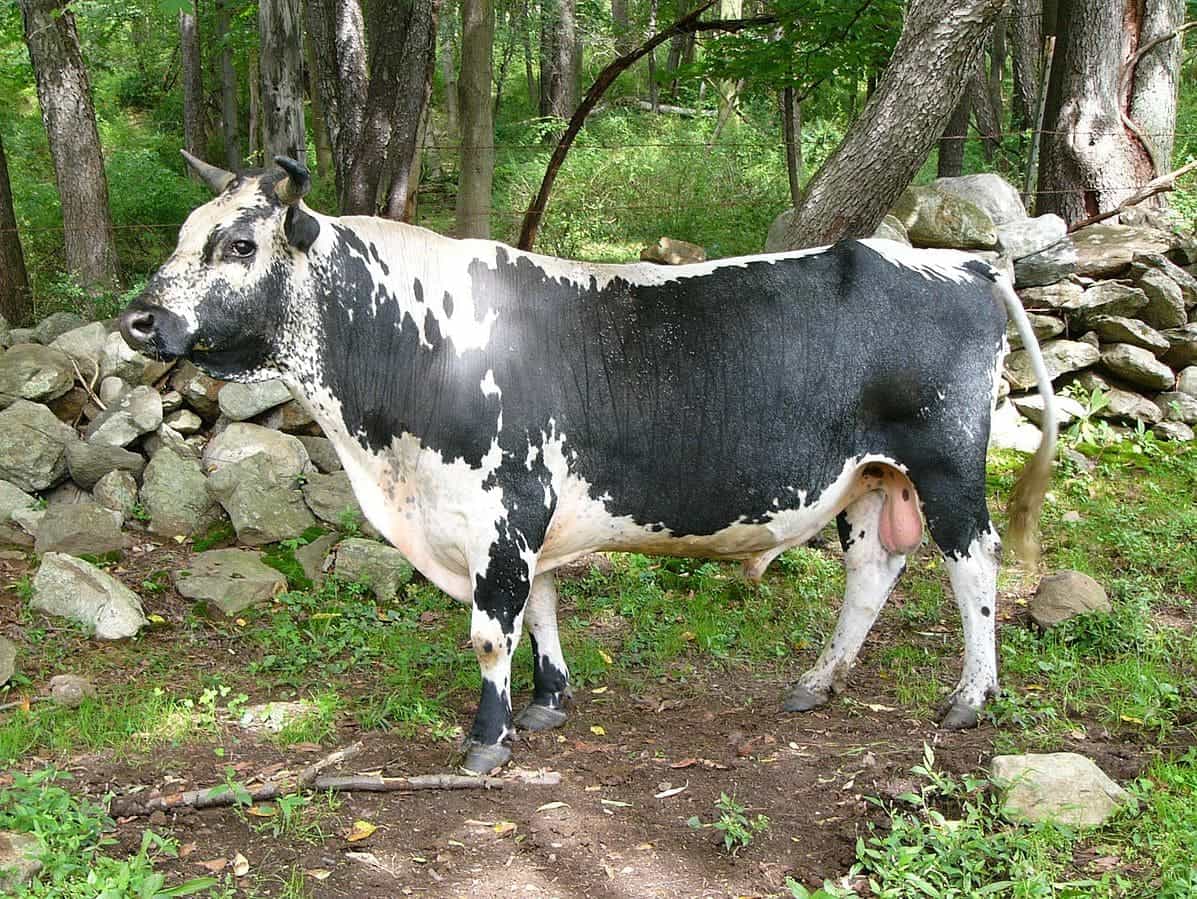When we think of cattle, we often think about the more popular breeds, like Herefords or Jerseys. We rarely consider the breeds that supported the early colonizers or what became of them.
The Randall cattle — or Randall Lineback — is one of the only two remaining breeds descended from the original landrace, all-purpose cattle used in the 1600s. Although these cattle can be used for dairy, meat, and draft purposes, their low yield makes them unpopular for mass-production purposes.
If you’ve never heard of Randall cattle, this guide will tell you everything that you need to know.

Quick Facts About Randall Cattle
| Breed Name: | Randall or Randall Lineback |
| Place of Origin: | Sunderland, Vermont, U.S.A. |
| Uses: | Dairy, meat, and draft |
| Bull (Male) Size: | 1,000–1,800 pounds |
| Cow (Female) Size: | 600–1,100 pounds |
| Color: | White with black, blue, mahogany, red, or gray markings |
| Temperament: | Docile but assertive; they need to be handled regularly |
| Climate Tolerance: | All climates |
| Care Level: | High |
| Milk Production: | 3.7% butter and 3.2% protein |
| Meat Production: | Lean with yellow fat or beefy and marbled |
Randall Cattle Origins
Randall cattle have their roots in the landrace breeds that were popular in New England during the 1600s. They were all-purpose cattle that gradually became less popular due to the increasing demand for milk and meat production, along with the advancements of farming technology.
In Sunderland, Vermont, during the 1900s, Samuel and Everett Randall created the Randall cattle breed that we’re familiar with today from the original lines of landrace cattle. After Everett Randall died in 1985 and his wife couldn’t continue caring for their herd, conservation efforts were put into the hands of Cynthia Creech.
Randall Cattle Characteristics
Highly intelligent, easy to train, adaptable, and willing to work, the Randall cattle breed is one of the best breeds for small farms. Handled regularly, they’re calm and docile but do have a stubborn, assertive side that can show if they’re left alone for too long.
While their survival instincts and adaptability stand them in good stead for low-input farming, training them for work as oxen can require regular interaction to curtail their stubborn bossy streak. Bulls, in particular, excel as working oxen. They’re generally large, heavy, and grow at a good rate, making them a powerful addition to your workforce,
The cows have strong maternal instincts and don’t often have issues with calving.
Once primarily used as dairy cows, Randall cattle are generally better for milk production with a yield that contains 3.7% butter and 3.2% protein. Their meat, on the other hand, can change in appearance depending on their family line. Randall cattle are well known for having either a marbled, beefy quality to their carcasses or leaner meat with yellowed fat.
Climate-wise, Randall cattle are highly adaptable. They excel in their original New England climate, as well as temperatures across the U.S.A. and Canada.
Uses
Unlike most modern cattle breeds, Randall cattle aren’t the most profitable farm animals available due to their roots as landrace cattle. Compared to other breeds, Randall cattle have a far lower yield of dairy and meat production. While they do well on small farms and homesteads, their inability to perform as well as modern breeds make them unpopular for large ranches.
As descendants of the original landrace cattle, though, this breed is well-known for their all-around uses. Not only can they be used for dairy and meat production, but they’re also hardworking draft animals.
Appearance & Varieties
While Randall cattle are considered medium-sized cows, their height, weight, and conformation tend to vary within the breed. Despite their multi-purpose use, most members are similar in build to other dairy cattle with developed udders.
Generally, the patterning throughout Randall cattle stays the same, with the shade of their markings changing depending on their genetics. Randall cattle have a “lineback” pattern, with a white base coat lining the back and black markings on both sides. The breed has also been known to have blue, brown, gray, mahogany, and red markings. Their ears, eye-rings, noses, and feet are often black.
Population, Distribution & Habitat
As one of the only two remaining landrace breeds remaining in the U.S.A., the Randall cattle is considered critically endangered. While these cattle are not as popular as those bred to produce a higher yield of meat and dairy, many people want to preserve the breed, including The Randall Lineback Breed Association founded in 2005.
In the U.S.A., there are only about 200 breeders of Randall cattle, and most of them are small, subsistence farm owners and homesteads. From the original 22 cows from Everett Randall’s farm, the population has since grown, but they are still the rarest cattle breed in the U.S.A.

Are Randall Cattle Good for Small-Scale Farming?
As an all-purpose cattle breed, the Randall Lineback is one of the best breeds for smaller farms. Their meat and dairy production are suitable enough for self-sustained farming, even if it doesn’t match the level of other breeds with higher yields.
Their use as draft animals is also beneficial for small farms that don’t have the means to afford heavy farm machinery. Randall cattle are intelligent and hard workers and can be used for plowing, along with other heavy farm work. We hope that this guide answered some of your questions about this rare cattle breed.
Featured Image Credit: Randall Bull Andy – CTPhil, Wikimedia Commonc CC0 1.0 Universal
